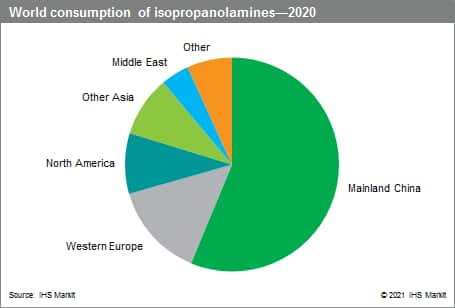Published March 2021
Isopropanolamines include monoisopropanolamine (MIPA), diisopropanolamine (DIPA), and triisopropanolamine (TIPA). They are provided either as single products or as blends. Isopropanolamines are used in a wide array of applications, including cement and concrete processing aids, gas purification, surfactants (primarily for home and personal care products), cosmetic formulations, corrosion inhibitors, metalworking fluids, and as emulsifiers, dispersants, and wetting agents.
Global consumption of isopropanolamines will continue to grow at an average annual growth rate of 3.8% during 2020– 25, driven by consumption in mainland China, India, Africa, and Southeast Asia. Combined consumption in these regions will continue to grow at an average annual growth rate of 4.5%, driven by the increasing use of triisopropanolamine (TIPA) for cement applications. These countries/regions, especially mainland China, continue to invest in a great deal of infrastructure—a large consuming application for cement.
The following chart shows world consumption of isopropanolamines:

For more detailed information, see the table of contents, shown below.
S&P Global’s Chemical Economics Handbook – Isopropanolamines is the comprehensive and trusted guide for anyone seeking information on this industry. This latest report details global and regional information, including

Key benefits
S&P Global’s Chemical Economics Handbook – Isopropanolamines has been compiled using primary interviews with key suppliers and organizations, and leading representatives from the industry in combination with S&P Global’s unparalleled access to upstream and downstream market intelligence and expert insights into industry dynamics, trade, and economics.
This report can help you
- Identify trends and driving forces influencing chemical markets
- Forecast and plan for future demand
- Understand the impact of competing materials
- Identify and evaluate potential customers and competitors
- Evaluate producers
- Track changing prices and trade movements
- Analyze the impact of feedstocks, regulations, and other factors on chemical profitability


















